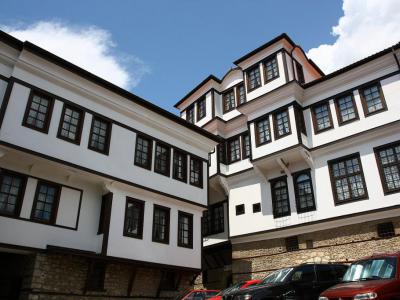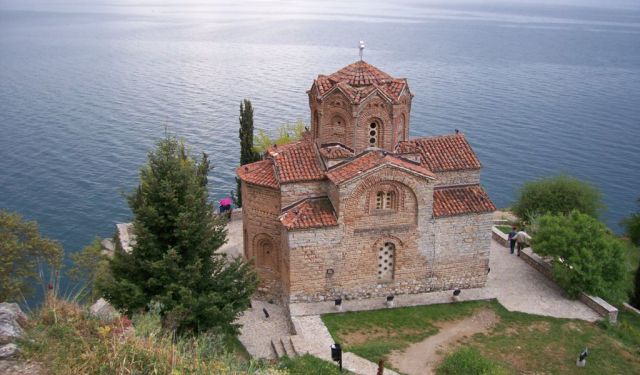
Robevi House. National Museum, Ohrid
Robevi House was built in its current state in 1863–1864 by Todor Petkov from a village Gari near Debar. The building of the first Robevi house was finished on the 15th of April 1827, as witnessed by the inscription in Greek on the marbled flagstone. This famous Ohrid merchant family lived in the house for 35 years between 1861–1862 when a famous criminal from Ohrid Ustref Beg burnt it to the ground. Two years later, between 1863–1864 the house was rebuilt. It was divided in two parts: left and right. Konstantin Robev lived in the left part of the house and his brother Atanas Robev in the right part. The main builder was Todor Petkov who built the house from scratch.
The house is a protected cultural monument consisting of 3 floors. Epigraphical monuments from Ohrid are placed on the ground part of the house including precious objects as the "Milokas" (found on the Via Egnatia) road, the two torsos of the goddess Isis etc. The archaeological objects from the ancient times and the medieval period are exhibited on the second and the third floor. The upper part of the house serves as exhibition space for objects made by the Ohrid carving school, creations of famous artists from Ohrid and the county.
Today the house is a protected cultural monument and belongs to the Institute for Protection of Cultural Monuments and National Museum.
The National Museum is a scientific, research and cultural institution in Ohrid. The essential part of its activities is the depot which houses approximately 800 icons dating from the XII to the XIX century. The most representative ones were relocated in the Ohrid Gallery of Icons. This Museum's current activities involve reconstruction and restoration of Tsar Samuil's Fortress, The Ancient Theatre and St. Clement's monastery of Saint Panteleimon at Plaosnik, as well as earlier complete reconstruction of the Robevs House. Today the house contains an archaeological display, an exhibition of articles from the Robevs household, artwork from the Ohrid Woodcarving School and archaeological excavations of Ohrid and its vicinity.
The house is a protected cultural monument consisting of 3 floors. Epigraphical monuments from Ohrid are placed on the ground part of the house including precious objects as the "Milokas" (found on the Via Egnatia) road, the two torsos of the goddess Isis etc. The archaeological objects from the ancient times and the medieval period are exhibited on the second and the third floor. The upper part of the house serves as exhibition space for objects made by the Ohrid carving school, creations of famous artists from Ohrid and the county.
Today the house is a protected cultural monument and belongs to the Institute for Protection of Cultural Monuments and National Museum.
The National Museum is a scientific, research and cultural institution in Ohrid. The essential part of its activities is the depot which houses approximately 800 icons dating from the XII to the XIX century. The most representative ones were relocated in the Ohrid Gallery of Icons. This Museum's current activities involve reconstruction and restoration of Tsar Samuil's Fortress, The Ancient Theatre and St. Clement's monastery of Saint Panteleimon at Plaosnik, as well as earlier complete reconstruction of the Robevs House. Today the house contains an archaeological display, an exhibition of articles from the Robevs household, artwork from the Ohrid Woodcarving School and archaeological excavations of Ohrid and its vicinity.
Sight description based on Wikipedia.
Want to visit this sight? Check out these Self-Guided Walking Tours in Ohrid. Alternatively, you can download the mobile app "GPSmyCity: Walks in 1K+ Cities" from Apple App Store or Google Play Store. The app turns your mobile device to a personal tour guide and it works offline, so no data plan is needed when traveling abroad.
Robevi House. National Museum on Map
Sight Name: Robevi House. National Museum
Sight Location: Ohrid, Macedonia (See walking tours in Ohrid)
Sight Type: Museum/Gallery
Sight Location: Ohrid, Macedonia (See walking tours in Ohrid)
Sight Type: Museum/Gallery
Walking Tours in Ohrid, Macedonia
Create Your Own Walk in Ohrid
Creating your own self-guided walk in Ohrid is easy and fun. Choose the city attractions that you want to see and a walk route map will be created just for you. You can even set your hotel as the start point of the walk.
Ohrid's Historical Churches
According to the legend based on the observations of 15th-century Ottoman traveler Evlia Celebia, the town of Ohrid used to have within its boundaries 365 chapels – one for every day of the year. At some point during Medieval times, Ohrid was even dubbed Slavic Jerusalem. Today, although the number of churches is considerably smaller, the architectural and historical value of those that remain... view more
Tour Duration: 1 Hour(s)
Travel Distance: 2.7 Km or 1.7 Miles
Tour Duration: 1 Hour(s)
Travel Distance: 2.7 Km or 1.7 Miles
Ohrid Introduction Walking Tour
Ohrid was called "Lychnidos", meaning "City of Light." By the late 9th century, the town was referred to as "Ohrid." This is Slavic, meaning "on a hill." With its 365 churches, it was known as "Jerusalem of the Balkans."
Legend says King Cadmus, banished from Thebes, founded the town on a hill overlooking the lucid waters of Lake Ohrid. That may... view more
Tour Duration: 2 Hour(s)
Travel Distance: 2.3 Km or 1.4 Miles
Legend says King Cadmus, banished from Thebes, founded the town on a hill overlooking the lucid waters of Lake Ohrid. That may... view more
Tour Duration: 2 Hour(s)
Travel Distance: 2.3 Km or 1.4 Miles


